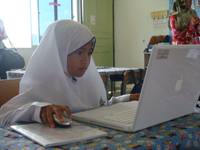Theme 2: Harnessing ICT and innovative digital low-cost solutions while ensuring access, equity and safeguarding during and post-COVID-19.
Thematic lead: Mohammad Santally
Peer Reviewer: Kim Ochs
Lead Organisation: University of Mauritius
Background
Covid-19 has brought about a sudden unexpected disruption in Education worldwide. Within weeks of the outbreak, millions of kids, young adults and mature learners were out of schools and universities. To cope with such an unforeseen and unusual situation, educational institutions resorted to what is widely being referred to as ‘emergency remote teaching’ to ensure some kind of continuity in the teaching and learning process.
In developing and developed countries alike, the response to the educational crisis was mainly centred on technology and digital media. Virtual teaching also referred to as online teaching, and the use of TV to broadcast recorded lessons for primary and secondary (high school students) were used, and Universities resorted to online delivery mainly through virtual lecturing, e-learning platforms and distance online learning (DEOL).
Such ‘emergency remote teaching’ measures had mitigated success and acceptance from the key stakeholders namely teachers, students and parents. One key issue (among many others) that was repeatedly highlighted was that of the digital divide which leads to the problem of digital inclusion for the underserved population who cannot afford technology, and those living in remote areas, where internet connectivity is still a problem (Bozkurt & Sharma, 2020).
Technology in education can be broadly categorized in two parts, namely high-end technology and low-end technology. Often, there is a tendency to think that high-end technology will have higher impact on learning and vice-versa for low end technology. This is not true as we can have a high-end technology with low impact on learning while we can have low-end technology with high impact on learning (Larson, 2017).
The key question therefore is - “how do we go about using low cost ICTs to harness innovative pedagogies and learning activities to promote active learning so as to ensure access, equity and safeguarding during and post-Covid 19?”
The premise therefore is not only about access, equity and continuity of the educational processes but also to ensure that meaningful learning takes place and that intended learning outcomes are achieved through the completion of a cycle comprising knowledge transfer, application and construction phases (Rajabalee et al, 2020).
Objectives / Key Research Questions
- What are the perceptions of parents, teachers and students on the effectiveness of the emergency remote teaching during Covid-19?
- What are the problems that were experienced from the teachers’ side and from the parents’ and students’ side to keep up pace with the emergency of the remote reaching during Covid-19?
- What technologies and methods were used to ensure continuity of teaching and learning covering primary to higher education?
- Which methods and approaches helped to reach the most of the student population especially the underserved, poor and those in remote areas?
- What was the perceived effectiveness of low-cost ICT solutions to ensure continuity of educational provisions in the underserved and remote communities?
- In what way the design and delivery of instruction has to be re-imagined to ensure maximum learning impact using solutions that promote universal access to educational provisions?
- How to involve parents, especially uneducated ones (or those with low education) in terms of providing support and commitment to their child’s education in remote teaching situations?
- What policy measures, technology solutions and other elements (e.g. related to capacity building of educators) to put in place to ensure universal access to educational provisions for these communities?
*Picture courtesy of The Commonwealth Secretariat

